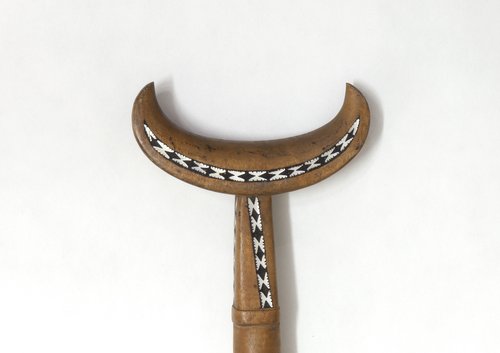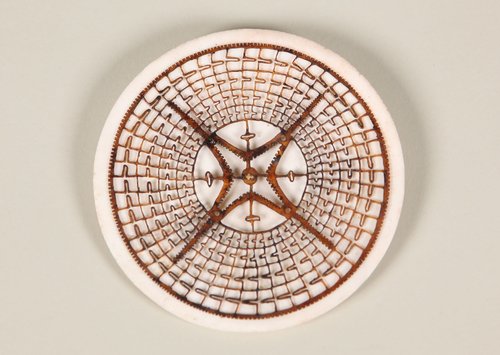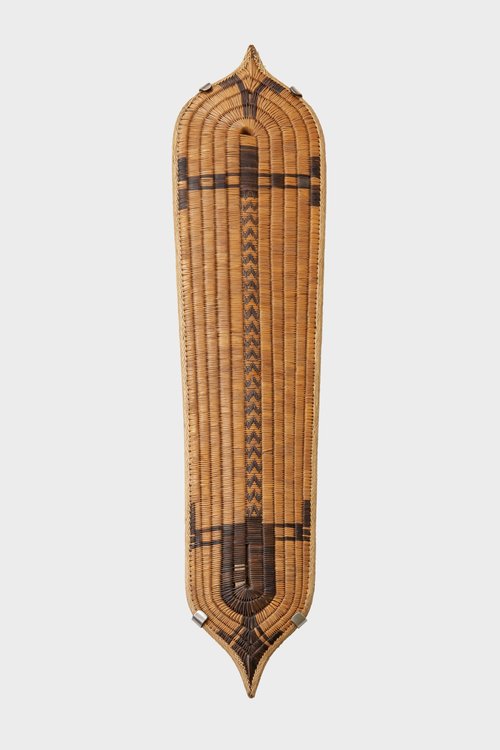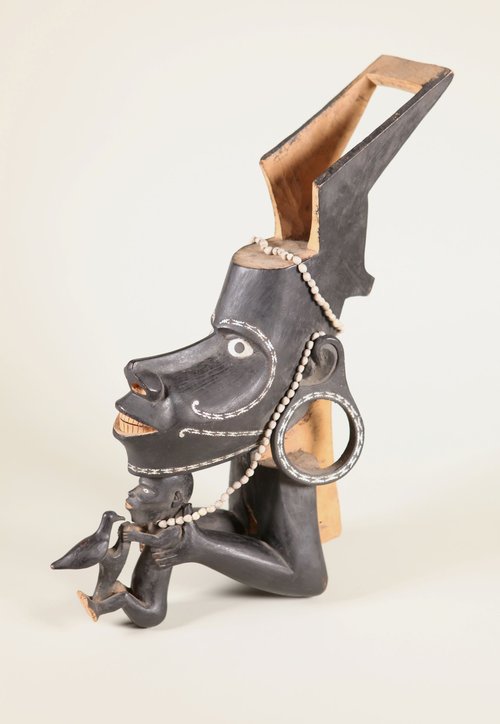
Ngā Taonga were fortunate to have Victoria University Pacific Studies intern Rebecca Chrystal on board for several months. Her final piece of work made a fascinating connection between Solomon Islands material in our Archive and across the country in the collection of Canterbury Museum.
When Canterbury Museum announced their travelling display of Solomon Island artefacts, Gifts for God, it sparked some excitement for me working as an intern at Ngā Taonga Sound & Vision. In our collection is The Transformed Isle, a missionary propaganda film just over an hour long and set on Vella Lavella in the Solomon Islands. The film has excellent anthropological value, as it gives us some visual evidence of how some of the artefacts in Canterbury Museum’s collection were made, worn and used.
Hero image: Decorated handle of a wooden paddle from the Solomon Islands (Courtesy of the Canterbury Museum - Ref E142.113.1)
The Transformed Isle was produced in 1920 over two weeks by South Australian clergyman the Reverend Reginald C Nicholson. It is a silent film and the intertitles use language that is very much of the period, the aim being to sway audiences to support the work of missionaries in the Pacific. The staging of the film is also worth noting. The Reverend Dr Allan Davidson of Auckland explains that Nicholson induced the Solomon Islanders of Vella Lavella to “re-enact the scenes of the past, dressed in the feathers and paint of warriors, setting out in their war canoes on head-hunting raids [and] dancing their war-dances”. Despite this artifice, through an anthropological lens the film has valuable footage of objects, artefacts and traditional craftmanship that fell into disuse in the face of a fast changing environment.
Around the same time – between 1921 and 1934 – New Zealand clergyman the Reverend Alfred Arthur Bensley made his way round the Solomon Islands. His role as a missionary was to convert the people to Christianity, and in doing so he gained a collection of “gifts for God” – items and artefacts that were acquired from Solomon Islanders. Most of these hand-made items were symbolically handed over by the people as they converted, as the value of these were thought to have diminished during the rapid changes of the time. This collection was eventually given to Canterbury Museum, which has housed it ever since.
Of course, the artefacts seen in The Transformed Isle and those in Canterbury Museum’s collection are not the exact same items, nor can they speak as exact examples for the whole of the Solomon Island chain, which was home to many different social groups. However, Bensely collected his “gifts for God” predominantly from the New Georgia Islands group, which included Vella Lavella, so the film and the collection can at least speak to each other, being connected by similar time period and location.
Connections between the collection at Canterbury Museum and the film we care for at Ngā Taonga is truly valuable. You go from having static artefacts in a display cabinet, to being able to see them in the context that they were used. Conversely, at the Museum, you are able to see some of the physical objects in more detail than the century-old footage is able to provide.

A 'Dala', from the Solomon Islands, is a disc shaped ornament with delicate filigree, worn over the forehead or shoulder by high-ranking individuals to signify their status. (Courtesy of the Canterbury Museum - Ref E146.295)
A prime example of this is the dala, an ornamental circular disk that was worn on the forehead by Solomon Islander warriors during battle or ceremonial occasions. Dala consist of two pieces: a clam shell that had been worked down into a round flat disk, with a hole drilled in the middle to attach the second piece. This piece was made of turtle shell that had been passed through with fibre or split cane in a sawing technique to create elaborate patterns – no two of which were the same – that would show up well against the clam shell.
Seeing the dala, it is hard to imagine how such intricate designs could be created without the use of modern tools like band saws. Shedding light on this process, The Transformed Isle has footage of the sawing taking place, the craftsman making careful adjustments as he works to create the design. There is also plenty of footage showing how the men wore the dala, although due to poor exposure the patterns are not quite visible. The dala that Canterbury Museum holds serve to illuminate that obscurity.

A 'Lave Lave' or battle shield, from the Solomon Islands. (Courtesy Canterbury Museum - Ref E142.103.1)
Other items worn by Solomon Island warriors were shields known as lave lave. They were long and thin, and made from cane, fibre and wood, aiming to be tough, but also light and manoeuvrable in the heat of battle. The physical item in Canterbury Museum exemplifies the materials and textures used in the lave lave, while footage from The Transformed Isle translates how lightweight and mobile that material allowed the shield to be.
Lave lave were often decorated with pigment and their stained patterns would identify rank and tribal identity. As valued possessions, they would be passed down through generations. Some men in the film can also be seen wearing arm ornaments made from clam shell. These were worn on the upper arm by men of social standing. One such arm ornament within the Museum collection is carved depicting a frigate bird, held in high esteem for its hunting ability.

A Solomon Island Nguzunguzu. (Courtesy of the Canterbury Museum - Ref E142.102)
Nguzunguzu (also known as musu or toto isu) were figureheads on the prows of tomoko, or war canoes. They were placed at the water level, rather than high up as on European vessels. Nguzunguzu acted as protectors against dangerous sea spirits, ensuring safe passage across the water. They can be seen when looking carefully at the footage of the war canoes in The Transformed Isle. To the untrained eye they look somewhat like rudders on the front of the canoes. One of these figureheads resides in the Canterbury Museum collection. Its face is elongated with stretched ears, and patterns of inlaid mother-of-pearl and shell that are similar to the war paint worn by Solomon Island warriors. This particular nguzunguzu is believed to have been made during the early 20th century and was collected by Reverend Bensley from Vella Lavella, where the film was made. It is particularly large, suggesting it may have been used as a gift or for trade rather than on a canoe.
Finally, with canoes come paddles. These paddles have a distinctive crescent-shaped grip at their top. The Museum collection has some long paddles, which would have been used for war or fishing canoes; our footage shows smaller examples, used by children for paddling about not far offshore.

A wooden paddle from the Solomon Islands. (Courtesy of the Canterbury Museum - Ref E142.113.1)
Ultimately, by forming links between collections across the GLAM sector, we are able to gain more insight into the precious taonga that is cared for across multiple organisations. We are able to see more clearly how artefacts are made and used, learn more about their physical details and gather all those bits of information to form a clearer picture of cultures and traditions that have been lost to time, social change and colonisation.
My sincere thanks to Canterbury Museum for its generous assistance with this blog.
All images in this post courtesy Canterbury Museum and all videos in this post are from The Transformed Isle.